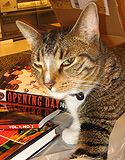A New Way with Vegetables
with Martha Holmberg
Let me start by saying that while this is a vegetable forward cookbook, it is not vegetarian, so if the thought of chicken or fish or pork touching your veggies makes you ill, this is not your cookbook. But if you enjoy occasional vegetarian dishes or just love veggies and are trying to find new ways to make them, then run out and buy this book immediately. It is terrific.
The book is divided into “six seasons” – the usual four that we all know, except summer is divided in thirds; early, mid, and late. The book is laid out in seasonal order, too, so if it is fall and you look in that section for recipes, you should easily be able to find those ingredients at your market or farm stand because they are in season. Get it? All that said, I live in South Florida so I had to throw all of that out the window since our growing “seasons” (and I use the plural loosely) are pretty much summer all year long except in summer, when it is just hot as Hades and not much grows except the mosquitoes.
There is an interesting forward and a few terrific essays:
How Getting Dirty Helped Me Become a Cook
How This Book Can Help You Become a Better Cook
What I learned While Writing This Book with Joshua
Then there are a few chapters that are out of season, if you will:
My Larder
Go To Recipes
Pickles: Six Seasons in a Jar
The rest of the book is laid out seasonally, starting with Spring.

It is also a beautiful book, nice heavy pages are actually sewn into the binding. I mention this because not a lot of cookbooks are that way, and it is a definite plus, especially with a big book like this one. It just means that the book will like flat on the counter when you cook from it. Did I mention it has about 275 recipes and is almost 400 pages long? Another physical feature of the book that I liked was that the pages are tipped in color so you can easily see the seasons.
McFadden has an interesting way of creating salad dressing that I haven’t seen before. He recommends adding the vinegar and seasonings to the salad and to keep tasting until you like it, then add the oil at the end. You don’t end up with an emulsified dressing but rather a well seasoned salad and I liked it. Not all the time, but when I get beautiful veggies from the farm and want to make a platter or simple salad, it just seems to work really well this way.
Besides recipes, there are lots of tips on how to buy, clean, and store your veggies which is very useful. There is an entire page on broccoli, then several recipes like Rigatoni with Broccoli and Sausage, which is a personal favorite. What I like about this recipe is the addition of “Whipped Ricotta,” although I would have liked it better if I didn’t have to flip to another page for that recipe, as well as for the dried breadcrumbs – not out of a can but yet another recipe within the recipe. I do like how clear the directions are for preparing the broccoli for this dish:
1 pound broccoli, stems trimmed and peeled, stems sliced crosswise into 1/4-inch coins, and tops cut into florets
Just takes the guessing out of it, which works for me. By the way, broccoli is a ‘midsummer’ vegetable. Early summer vegetables includes fennel, beets and the usually overlooked celery (a side note: check out the hilarious celery episode of “Portlandia“) and then make one of 7 celery recipes like “Celery Salad with Dates, Almonds, and Parmigiano” or “Braised Celery and Radicchio Salad with Perfect Roast Chicken.”
Late summer includes corn, eggplant, sweet peppers, and chiles among others. Recipes like “Corn and Tomato Salad with Torn Croutons” and Red Pepper, Potato, and Prosciutto Frittata Topped with Ricotta” are just light and easy summer suppers or sides.
Fall veggies include carrots, Brussels sprouts, artichokes and kale. Winter has these plus cabbage, turnips, kohlrabi and potatoes, and of course, winter squash. Recipes include “Pumpkin Bolognese,” “Turnip, Leek, and Potato Soup,” and a really unusual and delicious “Battered and Fried Cabbage with Crispy Seeds and Lemon,” a kind of cabbage leaf tempura that is heavily spiced and makes a wonderful appetizer.
Circling back around to the beginning of the book is Spring veggies, starring asparagus, English peas, Fava beans and lettuces. There is an adulterated version of carbonara with the lovely addition of those English peas that works really beautifully, and if you haven’t tried raw asparagus, spring is the time to do it with “Raw Asparagus Salad with Breadcrumbs, Walnuts, and Mint.” Add fresh mint to anything and I’m on board.
The “go to” recipes includes vinaigrettes like “Caper-Raisin Vinaigreette,” Pancetta Vinaigrette” and a wonderful “Lemon Cream” dressing. Also there are, butters like “Brown Butter,” “Pistachio Butter” and “Alla Diavola Butter” – yum! You’ll also find the “Whipped Ricotta” and a “Tonnato” sauce, an Italian tuna sauce. There are also come breads, like “Slightly Tangy Flatbreads” and “Pecan Dough” and really useful instructions on how to cook farro, freekeh and couscous. Pickles include a “Basic Vegetable Pickle Brine,” “Cold Brine,” and a”Hot Brine.”
Photographs abound and they are glorious. There is also an extensive index that is very useful as well. All in all, this is a beautiful cookbook that deserves a place on the bookshelf within easy reach.
6/18 Stacy Alesi, AKA the BookBitch™
SIX SEASONS by Joshua McFadden. Artisan; 1st Edition edition (May 2, 2017). ISBN 978-1579656317. 384p.





